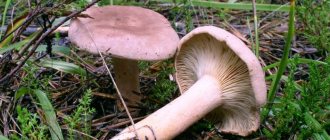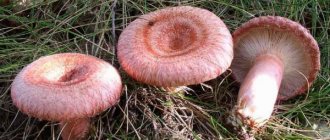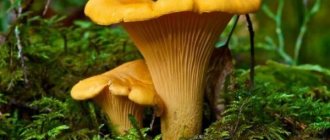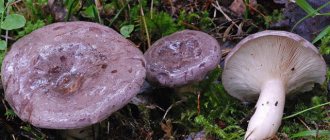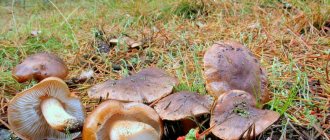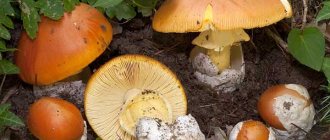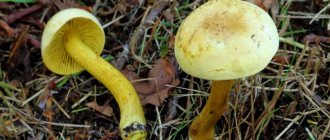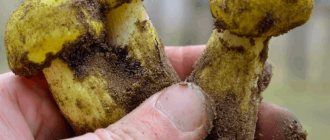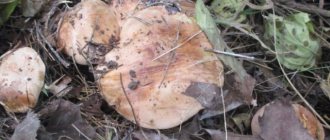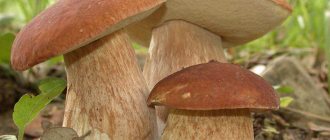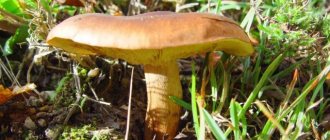The green row is a late “hello” of autumn for mushroom pickers, as it can be collected until the first frost.
Although mushrooms are a conditionally edible species, there are quite a lot of recipes for preparing dishes from the green row. We offer 3 simple recipes for preparing green row, which even a novice housewife can handle.
Description of the greenfinch mushroom
The greenfinch mushroom (Tricholoma equestre) belongs to the class Agaricomycetes, genus Tricholoma, family Rowaceae. The main names in Russian are: green row, zelyonka or zelenushka. They received this mushroom for its characteristic green color, which remains even after cooking. Refers to conditionally edible.
| Basidiomycota (Basidiomycetes) |
| Lamellar |
| Agaricomycotina (Agaricomycetes) |
| Agaricomycetes (Agaricomycetes) |
| Agaricomycetidae (Agaricomycetes) |
| Agaricales (Agaric or Lamellar) |
| Tricholomataceae (Tricholomaceae or Rowers) |
| Tricholoma (Tricholoma or Ryadovka) |
| Tricholoma equestre (Green row) |
| Zelenka, Green Sandpiper, Agaricus equestris, Tricholoma flavovirens |
| Greenish or lemon yellow, 5-12 mm wide, thin and frequent |
| Greenish yellow to olive |
| The diameter is 4-15 cm, in young fruits it is flat-convex with a tubercle in the center, in mature ones it is flatly spread with raised edges, covered with small scales on top. In wet weather the skin is sticky to the touch. |
| Dense, meaty. White or yellowish, does not change color when cut, with a characteristic powdery odor |
| Short, up to 5 cm long, about 2 cm in diameter, small brown scales at the base |
| White powder, 6-8x3-5 microns, ellipsoidal-oval, smooth |
| Forms mycorrhiza with coniferous trees, bears fruit until late frosts |
Synonyms:
- Agaricus equestris L;
- Gyrophila equestris;
- Glutinaster equestris;
- Melanoleuca equestris;
- Tricholoma auratum Gillet;
- Tricholoma flavovirens.
What does a greenfinch mushroom look like?
Collection rules
Green mushrooms are harvested in late autumn, when other mushrooms have already finished bearing fruit. The main part of the fruiting body of the fungus is usually hidden in a thick layer of soil, fallen leaves or pine needles. In an adult specimen, only the cap is visible above the surface of the ground, while a young specimen reveals itself as a small tubercle or crack in the soil.
The greenfinch is carefully cut off at the root with a sharp knife, then the base of the stem with the adhering soil is also cut off. Earth and forest debris stick tightly to the sticky skin, from which the green row must be cleaned when collected. Dirt is removed with a special brush or scraped off with a knife. When collecting green rows, preference should be given to young specimens that do not show signs of spoilage. It is characteristic that this variety of trichol is practically not damaged by insects.
Attention! When picking mushrooms, you cannot leave part of the stem in the ground; it will rot, which can cause the death of the entire mycelium.
The nutritional value
Greenfinch is not very high in calories, having only 19 kilocalories for every hundred grams. It consists of 46% protein, rich in valuable amino acids.
The other part of its composition, 49%, is occupied by carbohydrates, represented mainly by glycogen. And the fats present in the composition (5%) are mainly expressed in the form of phosphatides, lecithin and cholesterol.
Green grass protein has a whole range of amino acids beneficial to humans:
- tryptophan;
- arginine;
- lysine;
- serine;
- valina;
- glycine;
- histidine;
- threonine;
- isoleucine;
- aspartic acid;
- leucine;
- glutamic acid;
- methionine;
- phenylalanine.
- cystine;
- proline;
- tyrosine;
- alanine
Greenfinch is very rich in micro- and macroelements, among which the most is phosphorus, and also includes:
- iron;
- potassium;
- calcium;
- magnesium;
- zinc;
- selenium;
- sodium;
- manganese;
- copper.
Vitamins are also well represented in this mushroom in the form of:
- vitamin C;
- vitamin B6;
- vitamin B12;
- vitamin E;
- riboflavin;
- thiamine;
- vitamin D;
- vitamin D2;
- nicotinic acid;
- vitamin K1;
- pantothenic acid;
- folic acid;
- choline
Is it possible to eat green rowan
Green row is a conditionally edible mushroom. It has been proven that the skin and pulp contain toxins that have a negative effect on the human body. Even prolonged soaking and heat treatment do not lead to their complete destruction. Excessive consumption of greenfinches can cause food poisoning, disorders of the cardiovascular system and kidneys. It is believed that the largest amount of toxins is in the skin, and if it is removed, the problem will be solved. But that's not true. Toxins are present throughout the fruiting body and this must be taken into account. Green rower can be eaten only in cooked form and in small quantities.
Benefits and harm to the body
The green row is rich in vitamins and microelements. It contains most of the B vitamins, vitamins A, C, D, PP, copper, manganese, zinc, potassium, phosphorus, iron, sodium, selenium. It has antibacterial properties. Fomecin and clitocin contained in it are effective in the prevention of cancer. Greenfinches are low-calorie and at the same time very nutritious, therefore they are recommended for dietary nutrition. It is especially useful to consume these mushrooms for people with diseases of the pancreas and cardiovascular system. For those who have problems with the gastrointestinal tract, it is advisable to refrain from eating green rows. People who have problems with blood clotting should consult a doctor: greenfinch has the property of thinning it and inhibiting the activity of platelets.
The content of toxic substances in greenfinch mushrooms requires caution in their use. Only excess in eating can cause harm to the body. You should remember a simple truth: everything is poison, and everything is medicine, only measure makes the difference.
Greenfinch mushrooms: photo and description
These edible mushrooms are nicknamed green mushrooms because of their characteristic green color, which remains even after cooking and pickling. Many people are scared off by this poisonous color, but green flowers are quite a useful product.
Structure and features of the species
The fruiting body consists of a cap and a stalk. Visually they are easily separated.
hat
Convex in shape towards the middle, flat-spread with mushroom growth. Diameter from 4 to 12 cm. Color light olive with a yellow or green tint, brownish in the center. As the mushroom matures, the tones become darker. Thick skin. The cap has radially diverging small scales, which are sticky in wet weather, which is why a variety of forest debris and grains of sand often stick to it.
The hat can be olive, green-yellow. As the golden row grows and develops, the outer surface of its cap darkens, and in old mushrooms it becomes dark green. On the inside, the color of the cap is identical to the color of the leg; there are also many thin, oblong plates located there.
Pulp
Has a dense structure. In young mushrooms, the color is whitish, gradually acquiring a shade of yellow; the color does not change when cut. Yellowish under the skin. It has a slight smell of flour or cucumber, more concentrated when next to pine. Tasteless. Greenfinch is rarely affected by worms. The color of the plates ranges from light yellow with a faint color to yellowish-green in more mature specimens. Wide, frequent, notched. They grow from 0.5 to 1.2 cm in width.
Description of the greenfinch mushroom.
Leg
It is painted in the color of the cap, but in a slightly lighter tone. Short, almost “sunk” into the soil. At the exit it is covered with small dense scales with a brown tint, slightly thickened. Height 3-5 cm, girth 1.5-2 cm.
Eating
Greenfinch is a food product with a dubious reputation: on the one hand, it is believed that it is very tasty and suitable for consumption, and on the other, that this mushroom is dangerous and its use can lead to unpredictable consequences.
Until 2001, the mushroom was considered conditionally edible, but later cases of poisoning began to appear due to its excessive consumption. Even 3 deaths were registered in France. The toxins are believed to attack skeletal and smooth muscles, destroying them, and also cause rhabdomyolysis, which in severe cases leads to kidney failure.
Greenfinch recipes
We have selected for you several interesting and simple recipes for cooking mushrooms.
Salted crispy greens for the winter in jars
For 1 kg of greenfinches you will need the following list of ingredients:
- water – 200 ml;
- salt – 30 g;
- vinegar – 100 g;
- allspice peas;
- citric acid - a pinch;
- garlic - a couple of cloves;
- sugar – 1 teaspoon.
Cooking diagram:
- Prepared and soaked mushrooms must be placed in glass containers, sprinkle each layer with salt. The proportions at this stage are as follows: 1 layer of greenfinches - 1 tablespoon of salt.
- After this, the mushrooms are placed in barrels or deep wide pans and pressed down with pressure (a circle, gauze and a weight are placed). Next you need to wait for the juice to appear. After this, the weight can be removed, and currant or horseradish leaves can be used as a seal.
- The container must be tightly closed with a nylon lid and left for salting. Then you can start preparing the marinade.
- Next, place the pickled greenfinches in sterile jars. Process the container in a water bath, microwave or oven. All that remains is to fill the filled containers with hot marinade, add a small amount of vegetable oil and seal with nylon lids.
The finished product should be stored exclusively in a cool place: cellar, refrigerator or on the balcony.
Some time after salting, it is necessary to check whether the brine is present in the mushrooms - it must protrude a couple of centimeters higher. If there is no brine in the jars, then it needs to be added. Mushroom preparations will help diversify your daily diet or decorate your holiday table. Cooking does not require too much time, and with the help of recipes for cooking greenfinches, you can prepare an appetizing food for the winter.
It is recommended to salt greenfinches exclusively using a hot method. This is explained by the fact that green mushrooms, due to their specific color, contain a certain amount of toxic substances.
It is for this reason that they should be blanched before salting. In addition, heat treatment is necessary due to the fact that greenfinches, like any other mushrooms, are capable of absorbing harmful substances from the environment.
Marinade for greenfinches
For the winter, mushrooms are covered with a fragrant marinade, thanks to which the taste of the collected forest gifts is revealed.
What you will need to prepare the marinade:
- salt – 1.5 tbsp. l;
- black peppercorns – 10 pcs.;
- cloves - 2 buds;
- cinnamon - a pinch;
- sugar – 2 tsp.
Preparation:
- First you need to boil water, add salt, sugar and mix thoroughly.
- After boiling, add the necessary spices. Vinegar should be added at the rate of one teaspoon per liter container.
- After the mixture boils, let it sit for a few minutes.
The prepared brine will completely saturate the mushrooms and give them additional flavor.
If signs of mold appear on top, it must be periodically removed and the gauze and weight washed in hot salted water.
Afterwards everything is wiped down and covered again with a weight, a circle and gauze.
Pickled greenfinches
Ingredients:
- greenfinches – 9 kg;
- water for marinade – 4 l;
- bay leaf – 6 pcs.;
- black allspice peas – 10 pcs.;
- salt – 500 g;
- vinegar – 300 g.
Cooking instructions:
- Prepare the mushrooms as described above and place them in a large container (basin or pan). In a separate bowl, mix five liters of water and 300 g of salt. Pour in the prepared ingredients and leave for 12 hours. After the specified time, remove the mushrooms and rinse thoroughly under running water.
- Boil 3 liters of water in a deep and wide saucepan, place the greenberries in the bowl and cover with a lid. As soon as the mixture boils, you need to reduce the gas and boil the mushrooms for one hour. Next, use a slotted spoon to remove the boiled fruits from the container.
- Then start preparing the marinade: boil 4 liters of water in another bowl, add bay leaf, pepper, salt and mix well. To enhance the taste and aroma, cherry and currant leaves, garlic cloves, dill or horseradish are often added.
- Place the mushrooms in the boiling marinade and boil for ten minutes. Then add vinegar to the pan and mix thoroughly. Boil the ingredients for another five minutes and then turn off the heat.
- Place the prepared product in sterile glass jars, fill to the top, add marinade and seal. Storage containers can be processed in a water bath, oven or microwave.
To ensure that pickled mushrooms do not lose their taste and aroma, they must be stored at a temperature of + 5 degrees.
Where do they grow, in what forests and how to collect greenbushes
Mushrooms of this type are widespread everywhere. They can be found throughout the Russian Federation.
The usual place of distribution of greenflies is pine forests (usually dry) growing on sandy soil. They are also found on light loamy, sandy and sandy loam soils when the rest of the edible mushrooms have already “moved away”, just before the onset of cold weather. This may be why green rows are almost never wormy.
Usually green mushrooms inhabit the sides of forest roads, but they are still difficult to notice, since fallen leaves hide the green mushroom with a cap. With the onset of frost, the mushrooms hide under the needles. Sometimes green rows can be found in the vicinity of earrings, which will make harvesting the last harvest more enjoyable.
They grow both in small groups of 6-8 specimens and singly, choosing well-lit clearings with a high level of humidity.
Collecting greenfinches is not as simple as it seems. Only patient mushroom pickers will be able to find a large number of tasty green mushrooms, and after finding the hidden prey, it is necessary to clean the crop from sand, dirt and leaves.
Cleaning mushrooms from impurities is a mandatory measure, since they easily absorb various components located nearby and in the ground. Experts do not recommend collecting specimens in the area of railways and highways, where there are a lot of substances harmful and dangerous to the human body. It is also not recommended to collect greenfinches even on the city border, since this area is also highly likely to be polluted by industrial waste. Mushrooms grown far from sources of infection are clean and healthy products suitable for collection and consumption.
Simple recipes
There are many options for preparing ryadovka; you can preserve it, fry it, prepare soup, or prepare pickles. Young mushrooms are good for first courses, roasts, and sauces. They do not lose their taste after freezing or being dried. However, traditionally, serushkas and greenfinches are salted and pickled. They are especially wonderful this way!
The quality of the dish largely depends on proper primary processing. The row should be thoroughly cleaned of adhering debris, soaked in cool water, and then boiled for 15 minutes.
Hot salting
Hot salting is one of the most popular methods of preparing gray and green rows. Mushrooms prepared in this way remain dense and crispy.
Ingredients:
- boiled rows – 5 kg;
- water – 1 l;
- salt – 200 g;
- pepper, bay leaf and other spices - to taste.
How to prepare pickles:
- To prepare the brine, salt is dissolved in boiling water and allowed to boil for 2-3 minutes.
- Prepared mushrooms are laid out in layers, interspersed with spices: garlic, peppercorns, bay leaves.
- Fill with brine, cover with gauze or other material, and apply pressure. For example, a wooden circle and a stone on top or a pot of water.
- When the water has cooled, the mushrooms can be moved to a cold place.
- The salting process will take 25-30 days.
How to cold salt?
Thanks to a variety of spices, cold-salted serushki and greenfinches become incredibly fragrant. However, seasonings must be added carefully so as not to overpower the delicate taste of the mushrooms.
Ingredients:
- boiled mushrooms – 1 kg;
- coarse rock salt – 40 g;
- allspice – 5 peas;
- black pepper – 7 peas;
- bay leaf – 3-4 pcs.;
- cloves – 2 pcs.;
- garlic – 2 cloves;
- black currant leaves, dill umbrellas - to taste.
Preparation:
The bottom of a non-metallic dish (enamel, plastic or glass is suitable) is covered with currant leaves, dill, garlic cut into slices and a few peppercorns are added. Separate the cap of the mushrooms from the stems so that they lie in even rows. Lay the first layer with a pinch of salt. Add the remaining mushrooms, sprinkling them with salt and spices (garlic, pepper, cloves). Cover the mushrooms with clean gauze and top with a plate of suitable diameter. Install oppression. The workpiece is removed to a cool place. Check periodically - the released juice should completely cover the mushrooms
If there is not enough liquid, you can add chilled boiled water. It is important not to cover the container with a lid so that the fermentation process that has begun does not lead to souring of the mushrooms. After 30-50 days, the salted mushrooms are ready.
Marinating at home
Pickled canned rows have a spicy taste with pungency and sourness. A variety of spices and vinegar extend the shelf life of mushrooms.
Ingredients:
- boiled greenfinches and/or earrings – 1 kg;
- water – 2 l;
- salt – 3 tbsp. l.;
- vinegar essence – 3 tsp;
- black pepper – 10 peas;
- cloves – 2 pcs.;
- cinnamon – 1 stick.
How to pickle serukha and green nuts:
- Bring the water to a boil, add salt and spices. Cook over medium heat for 15 minutes.
- Remove the marinade from the stove. Vinegar is added last.
- Mushrooms are placed in sterilized jars and poured with hot marinade.
- Roll up the jars and turn them upside down for 12-24 hours.
- Store the workpiece in a cool place.
How to distinguish greenfinch from false, inedible mushrooms?
In appearance, the greenfinch is similar to several other species of this family. For example, with chamois row, a poisonous mushroom that causes mild gastrointestinal disorders. Therefore, it is important to be able to distinguish between edible and poisonous varieties.
The mushrooms have a similar color (yellow-green, yellowish) and cap diameter. In order not to confuse them and not expose yourself to danger, you should know the differences between species: sulfur row always has a rich, unpleasant odor, reminiscent of the smell of tar and hydrogen sulfide. It has few plates; they are always attached to the stem, which reaches up to 11 cm in height. As they age, little mice, as the gray mouse is also called, acquire a rusty or brown color.
The other two inedible species with which greenfinch can easily be confused are the sultry row and the solitary row. You can recognize them like this:
- The sultry row has a sharp, unpleasant smell and taste, and is also smaller in size.
- The isolated row is characterized by a sharply unpleasant odor and bitter taste, and has white or yellowish-tinged plates that are not as densely spaced as those of greenfinch.
Dangerous false doubles
Poisonous greenfinch imitator:
- Sulfur row (Latin name: Tricholoma sulphureum) - has a smaller size, bright sulfur-lemon color, yellow flesh, bitter taste and bad odor. Grows in coniferous and deciduous groves in July–October.
Sulfur row
Inedible lookalikes:
- Separated row (lat. Tricholoma sejunctum) - it has rarer plates than the golden row, yellowish or white. The pulp is bitter.
- Sultry row (lat.Tricholoma aestuans) is a smaller fruit with a bad smell and taste.
Spruce row
Separate row
Podzelenka is also similar to some of its brethren, ranging from mildly poisonous to edible. This:
Pointed row (lat. Tricholoma virgatum) is a poisonous mushroom with a thinner, ash-colored cap with a mound in the center. The plates are grayish in tone. The pulp is hot to taste.
Soap row (lat. Tricholoma saponaceum) is an inedible species. It has a more uniform color and no fibrousness. Smells strongly of laundry soap.
The different row (lat. Tricholoma sejunctum) is conditionally edible. The leg can be white, chestnut, green. The pulp has a bad smell.
Tricholoma terreum (lat. Tricholoma terreum) is an edible species. Significantly smaller in size. The surface of the cap is fibrous and scaly. The plates are rarer, steel-colored.
False doubles
Representatives of the family are very similar to each other in the structure of the fruiting bodies, but differ mainly in color. A characteristic feature that unites all types of rows is the scaly or fibrous surface of the caps. Comparing photos of a row of greenfinch with images of false varieties will help inexperienced mushroom pickers learn to distinguish between them.
Advice! Inedible and poisonous rows can be distinguished from edible ones by their sharp, unpleasant odor.
Sulfur-yellow row (Tricholoma sulphureum)
Most often, greenfinch is confused with the inedible sulfur-yellow row. It has a flat-convex cap of a bright sulfur-yellow color, light at the edges and darker in the middle. The plates are thick, sparse, yellow or green-yellow. The cylindrical leg of a lighter shade is often curved. The pulp is the same color or greenish, characterized by a bitter, burning taste, and emits an unpleasant odor of hydrogen sulfide. Eating it is dangerous to health.
Spruce row (Tricholoma aestuans)
An inedible mushroom that, when eaten, causes upset of the digestive system. The fruiting body of the mushroom is greenish in color with a brown tint. The cap is 3-10 cm in diameter, bell-shaped or flat with a small tubercle in the center, sticky, shiny, scaly. There are barely visible radial stripes on the surface. The plates are yellow, thin, and frequent. Mature mushrooms are prone to cracking. The pulp is whitish or light yellow. Compared to the green row, the spruce one has a less fleshy cap, a longer and thinner stem, bears fruit in August-September, and does not “hide” in the litter.
Solitary row (Tricholoma sejunktum)
Experts are divided in their opinions about this variety of rows: some consider it inedible, others consider it conditionally edible. Despite the bitter taste and medicinal smell, many salt and pickle the isolated row, first soaking it for a long time and boiling it in several waters.
The mushroom has a convex, dark olive cap covered with scales with a characteristic tubercle in the middle and downward curved edges. The plates are white or grayish, wide, sparse, free. The leg is dense, long, covered with small scales. Its color varies from white-green at the top to dark gray at the bottom. The pulp is white in the cap and yellowish in the stem, bitter. Separate rows are collected from August to October.
Soap row (Tricholoma saponaceum)
The soap row hat can have a wide variety of colors: light and dark brown, olive green, olive brown. The plates are pale, greenish-yellow, yellow-gray, adherent, sparse. The pale greenish-yellow cylindrical leg widens towards the base, becoming pale pink in adult specimens. The pulp is white or yellowish, with an unpleasant taste and strong smell of fruit soap, and turns red when cut.
Deciduous row (Tricoloma frondosae)
The mushroom has another name - aspen greenfinch. The cap is 4-15 cm in diameter, bell-shaped or prostrate with a wide tubercle in the center, greenish-yellow, olive-yellow or sulfur-yellow. The middle of the cap is covered with brownish scales, the edges are uneven, and over time they rise upward and curl up. The plates are frequent, emarginately adherent, yellow or greenish. The leg is long, thin, the same color as the cap. The pulp is white or yellowish, with a pleasant mild taste and faint aroma. The mushroom is conditionally edible, just like the green row, it contains toxins.
Green russula (Russula aeruginea)
An unpretentious mushroom that grows under any trees, often under conifers. It has a green or yellow-greenish cap, convex or depressed, with a sticky surface and grooves along the edges. The leg is straight, white with rusty-brown speckles. The plates are frequent, adherent, white, sometimes with rusty spots. The pulp is brittle and bitter.
Greenish russula (Russula virescens)
It has a fleshy, matte, yellow or blue-green cap, hemispherical in young mushrooms, and prostrate in mature ones. The leg is white, with brownish scales at the base. The plates are frequent, creamy-white, forked-branched. The pulp is dense, whitish, not caustic, but has a pungent taste.
Greenfinch can also be confused with cobwebs - odorous or black-green. They are not poisonous, but do not have good taste. A characteristic distinguishing feature of cobwebs is a cobwebby cover, which in adult mushrooms remains in the form of a ring in the upper part of the stem and cobwebs along the edge of the cap.
Black-green cobweb in the photo:
It is impossible to confuse the green toadstool with the deadly poisonous toadstool. The pale yellow color of the cap, the leathery “skirt” at the top of the stem and the cup-shaped volva at the base - thanks to these features, the toadstool can be easily distinguished from other mushrooms.
Secrets of mushroom pickers
- You should take a knife with you on a quiet hunt. It will be useful for two things: cutting mushrooms and preparing a stick for yourself. It is necessary on a hike to save energy: you won’t have to constantly bend over to search, but just rake away the leaves.
- The harvest should only be processed on the day of harvest! Mushrooms are a perishable product, and cooking them the next day is already a health risk.
- The collected fruits must be sorted, washed and inspected. Throw away any wormy or overripe ones immediately. Old copies can also be dangerous.
The inconspicuous appearance of greens does not evoke a pleasant taste. They are the least known member of the family. Therefore, some mushroom pickers consider it inappropriate to waste time collecting them. And in vain. The fruit is edible and tasty. And besides, since it is the latest, it provides the opportunity to take a last walk through the forest and enjoy the process before nature’s long winter sleep.
How to prepare green rows for the winter
How to prepare green row for the winter by simply frying it in vegetable oil? This option is quite simple, because it requires a minimum of ingredients. However, the snack will turn out very tasty and aromatic.
- 3 kg of green row;
- Vegetable oil;
- Salt and a mixture of ground pepper - to taste.
- Traditionally, pre-clean the green row: rinse, cut off the stems at the base and boil for 30 minutes.
- Leave to drain and cool, using a colander as you go.
- Pour a lot of oil into the pan, add the mushrooms and fry for 40 minutes. over low heat.
- Add a little more salt to taste and sprinkle with a mixture of ground pepper.
- Mix thoroughly and continue frying for another 20 minutes.
- Distribute into sterile dry jars, add oil from the frying pan and close with tight nylon lids.
- Take to a dark, cool room, or store in the refrigerator.
Cooking Zelenukha according to the recipe: how to cook, photos and descriptions of dishes
Today, there are more than a hundred recipes for making Greenies at home. With their own hands, cooks manage not only to pickle and salt, but also to freeze fruits for the winter after heat treatment. There are also options that offer frying and steaming. However, compared to classic recipes, mushrooms lose their main advantages: a crispy texture reminiscent of pickles and a captivating aroma diluted with spices and aromatic herbs.
Heat treatment
Preparation of a variety of rowing begins immediately after returning from the forest. Before washing, the fruits are re-inspected for damage, rotting and pest damage. If there are wormy specimens, the mushroom is thrown into a trash can, considering it unsuitable for cooking.
How to clean and rinse green mushrooms from sand?
The next step is rinsing under running water and cleaning with a knife. Contaminants are cut and scraped off to prevent sand from getting into the preparation for the winter, the first or second course. If the collection took place during rain, it is worth using gloves during cleaning so as not to stain your hands with a dark coating as a result of the chemical reaction formed when the mucous fungal layer comes into contact with the skin.
To clean the mushrooms faster when you get home, you should soak them in warm water for half an hour or more, during which time the plates will open and sand will spill out of the mushrooms.
Other housewives advise soaking greenfinches in water at room temperature for 1 hour, stirring them from time to time, and then rinsing thoroughly.
If there is enough time for preparation, it is worth soaking the fruits for 3-5 hours in salted water. The procedure will remove the existing bitterness by clearing the fruits of the remaining sand that has clogged deep into the lamellar layer.
Upon completion, the mushrooms are washed again and checked for the presence of a film on the caps. Missed specimens are cleaned and laid out on a paper towel until dry to prevent excess moisture from entering during cooking and digestion.
Greenfinches and greenfinches can be easily cleaned of sand if you soak them in warm water for half an hour
The following recipe will help you remove sand from lamellar mushrooms:
- Place the mushrooms, cleared of sand and grass, into a large bowl.
- Stir a handful of salt in a full bucket of clean water and pour over the mushrooms for 1 hour. Take 3-4 times more water than mushrooms so that they float in the water.
- Every 7-10 minutes, mix the mushrooms in the water.
- We wash each fungus, put it in another deep bowl, and fill it again with clean water, but without salt, again for 1 hour. Change the water 3-4 times and that will be enough.
- You can also rinse the mushrooms once under running water after using salt water.
The first two times, the mushrooms are boiled for 20-30 minutes in different waters to eliminate any remaining toxins in the pulp. Next, Zelenushki are dried and prepared according to any of the recipes you like, taking into account the calculation for 1 kg.
How long to cook and fry
Blanch the mushrooms for half an hour after boiling. This is a must. The boiling time cannot be reduced, even if further cooking of the dish involves additional heat treatment. Do not forget that greenfinches are conditionally edible.
Note! This means that they are allowed into food only after certain processing. You can check the degree of readiness in the following way: well-cooked mushrooms settle at the bottom of the pan.
Boiled mushrooms are dried and sent to a frying pan for frying or transferred to a roasting pan for stewing. Cooking time takes from 15 to 20 minutes. Green mushrooms are fried and stewed in the same way as other mushrooms.
Due to their color, greenfinches look unusual. These mushrooms can be eaten, but only after complex processing.
What ingredients does it go with?
Like most mushrooms, Greenfinch goes well with herbs: basil, saffron, parsley and dill. Most recipes include adding vegetables and berries to the pulp: onions and lettuce, garlic, cabbage, cranberries, eggplants and even bell peppers. To obtain a crispy consistency for preparations for the winter, add: cherry, horseradish and oak leaves.
The preparation of first and second courses combines Zelenukha with various ingredients, but the following dishes are considered the most delicious:
- fried potatoes with mushrooms;
- baked goods: pies, pies, buns;
- salad in a jar;
- baked potatoes with onions and mushrooms;
- assorted mushrooms;
- rich mushroom soup;
- vegetable stew with the addition of green stuff and meat.
The choice of any dish you like depends on the availability of free time, culinary skills and taste preferences. If you want to prolong the enjoyment of mushroom taste, you should prefer pickling and canning, which quietly preserve freshness for 6-12 months, provided that it is stored in a cellar, pantry or refrigerator.
Recipes for dishes with greenfinch
Including greenfinch in your diet will improve the taste of food and give it a piquant aroma. This mushroom goes well with meat, fish, vegetables, eggs and even berries. It can be fried, dried, frozen, salted, boiled and pickled.
The following recipes for greenfinch are distinguished, which are characterized by low calorie content and benefit the body:
Thin crust pizza
. A tablespoon of dry yeast is diluted in 2 glasses of warm water and allowed to stand until bubbles appear. Pour a teaspoon of salt and 3 cups of wheat flour, 4 tablespoons of olive oil and ready-made yeast into a container. The dough is mixed and allowed to brew a little. Meanwhile, 100 grams of ham and 50 grams of green stuff are cut into small pieces, and 100 grams of hard cheese are grated. Grease baking trays with oil and roll out dough onto them. The edges are made thicker than the center. Cover the top of the cake with 2 tablespoons of tomato paste and spread the filling. Bake in the oven at a temperature of 175-180°C for about 20 minutes. A few minutes before taking out, sprinkle the pizza with chopped herbs and cheese.
Draniki with greenflies
. 2 large potatoes are peeled and grated, onions are peeled and finely chopped. Using a blender, beat 1 chicken egg, 3 tablespoons of flour, 50 grams of green mushrooms, 20 grams of butter, 3 cloves of garlic and 70 grams of hard cheese. The ingredients are sprinkled with salt, spices and mixed. Place the dough in pancakes on a hot and oiled frying pan and fry over low heat until golden brown. Draniki go well with sour cream.
Potatoes with meat and mushrooms
. Heat a frying pan and grease it with vegetable oil, in which you should fry the chopped onions and 200 grams of chopped greens. After three minutes, add half a kilogram of chopped pork, mix and fry for 15-20 minutes. 10 potatoes are peeled, cut into cubes, and cooked until golden brown. After this, pour in a glass of filtered water. Then you should mix everything thoroughly, adding salt afterwards. If necessary, pepper and add herbs and bay leaf. Next, cover the dish with a lid and simmer for about 20 minutes.
Chicken sausages with greenfinches
. 2 heads of white onions and 4 cloves of garlic are peeled, passed through a press and added to a kilogram of minced chicken. Then 350 grams of greenfinches are finely chopped and added to the meat along with spices and salt. The natural casing is stuffed with ingredients and formed into sausages, which should be pierced in several places so that they do not burst from the juice during frying. Grill the sausages for about 15-20 minutes until clear liquid begins to flow out.
Pancakes with mushroom sauce
. 150 grams of greenfinches are fried together with chopped onions. Then beat 3 chicken eggs, 500 ml of low-fat kefir, a teaspoon of salt and soda, a tablespoon of sugar and 300 grams of sifted wheat flour with a blender. The dough will be the same consistency as for pancakes. Then pour in 3 tablespoons of vegetable oil and let the dough stand for an hour. After this, put chopped mushrooms, onions, herbs on a heated frying pan and pour in a layer of dough. Fry for 1-2 minutes on each side. The dish goes well with sour cream.
Tortiglioni in lentil-tomato sauce
. 700 grams of lentils are washed and boiled until tender. Then 3 stalks of celery, carrots and onions are chopped and fried in an oiled frying pan until cooked. 100 grams of chopped greens and boiled lentils are added to the vegetables. In a separate container combine 2 tablespoons of tomato paste, 2 teaspoons of sugar, a teaspoon of salt, a pinch of citric acid, 3 cloves of garlic passed through a press, black pepper powder to taste, a teaspoon of adjika and 150 ml of water. The resulting sauce is poured over the lentils, simmered for approximately 7-10 minutes, and chopped herbs are added. A pack of tortiglioni is boiled as written on the manufacturer’s packaging and added to the rest of the ingredients. Then pour in 200 ml of water for greater juiciness and simmer for another 3 minutes. The finished dish can be decorated with baked cherry tomatoes.
Mushrooms in sour cream
. Greenberries are cleaned, cut into slices and thrown into a heated frying pan, generously greased with butter. Fry until all the liquid has evaporated. A head of white onion is cut into rings and added to the mushrooms. Then everything is salted, peppered and 4 cloves of garlic are passed through a press. Next, pour in 4 tablespoons of sour cream and simmer the ingredients over low heat for about 15 minutes under the lid.
